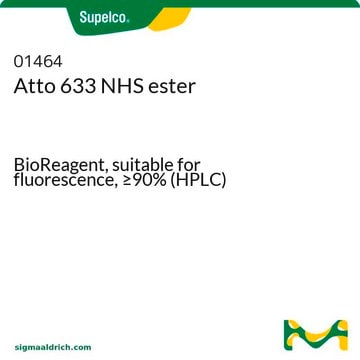16805
Atto 425 NHS ester
BioReagent, suitable for fluorescence, ≥90% (HPLC)
Synonym(s):
Atto 425-N-hydroxysuccinimide ester
About This Item
Recommended Products
product line
BioReagent
Assay
≥90% (HPLC)
≥90% (degree of coupling)
manufacturer/tradename
ATTO-TEC GmbH
solubility
DMF: soluble
DMSO: soluble
H2O: soluble
λ
in ethanol (with 0.1% trifluoroacetic acid)
UV absorption
λ: 422-428 nm Amax
suitability
suitable for fluorescence
storage temp.
−20°C
SMILES string
CCOC(=O)C1=Cc2cc3C(C)CC(C)(C)N(CCCC(=O)ON4C(=O)CCC4=O)c3cc2OC1=O
InChI
1S/C26H30N2O8/c1-5-34-24(32)18-12-16-11-17-15(2)14-26(3,4)27(19(17)13-20(16)35-25(18)33)10-6-7-23(31)36-28-21(29)8-9-22(28)30/h11-13,15H,5-10,14H2,1-4H3
InChI key
PUEQEMDTFPYCDY-UHFFFAOYSA-N
Related Categories
General description
Application
Other Notes
Legal Information
Storage Class Code
11 - Combustible Solids
WGK
WGK 3
Flash Point(F)
Not applicable
Flash Point(C)
Not applicable
Personal Protective Equipment
Certificates of Analysis (COA)
Search for Certificates of Analysis (COA) by entering the products Lot/Batch Number. Lot and Batch Numbers can be found on a product’s label following the words ‘Lot’ or ‘Batch’.
Already Own This Product?
Find documentation for the products that you have recently purchased in the Document Library.
Customers Also Viewed
Our team of scientists has experience in all areas of research including Life Science, Material Science, Chemical Synthesis, Chromatography, Analytical and many others.
Contact Technical Service






